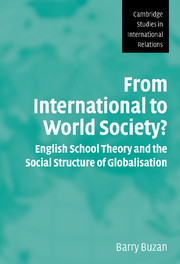 From International to World Society?
From International to World Society? Published online by Cambridge University Press: 14 January 2010
As Little (2000: 411) notes, world society is ‘the most problematic feature’ of the English school framework. Yet that world society is crucial to English school theory cannot be in doubt. If English school theory is to work as a vehicle for a methodologically pluralist approach to IR, then each of its three pillars must have the same clarity and the same standing as the others. Yet what world society means in relation to solidarism is far from clear, with a consequent blurring of the boundary between international and world society. In figure 1, the conjunction of international system and realism/Hobbes is wholly conventional, and that of international society and rationalism/Grotius poses no obvious difficulties (notwithstanding that there are substantial debates going on about how to interpret Hobbes, Machiavelli and Grotius). But the conjunction of world society, revolutionism and Kant rings several alarm bells. Revolutionism seems particularly out of line with most of what is currently discussed under the heading of world society, and it is not clear that Kant fits comfortably with either image. Transnationalism, cosmopolitanism and crusading universalist ideologies are implausibly crammed together in the world society segment. To make matters worse, the world society segment lacks a ‘world system’ counterpart: international system and international society compose a clear set, differentiating physical systems of interaction from socially constructed ones. World society is clearly aimed at socially constructed non-state systems, but what is its physical counterpart?
To save this book to your Kindle, first ensure [email protected] is added to your Approved Personal Document E-mail List under your Personal Document Settings on the Manage Your Content and Devices page of your Amazon account. Then enter the ‘name’ part of your Kindle email address below. Find out more about saving to your Kindle.
Note you can select to save to either the @free.kindle.com or @kindle.com variations. ‘@free.kindle.com’ emails are free but can only be saved to your device when it is connected to wi-fi. ‘@kindle.com’ emails can be delivered even when you are not connected to wi-fi, but note that service fees apply.
Find out more about the Kindle Personal Document Service.
To save content items to your account, please confirm that you agree to abide by our usage policies. If this is the first time you use this feature, you will be asked to authorise Cambridge Core to connect with your account. Find out more about saving content to Dropbox.
To save content items to your account, please confirm that you agree to abide by our usage policies. If this is the first time you use this feature, you will be asked to authorise Cambridge Core to connect with your account. Find out more about saving content to Google Drive.